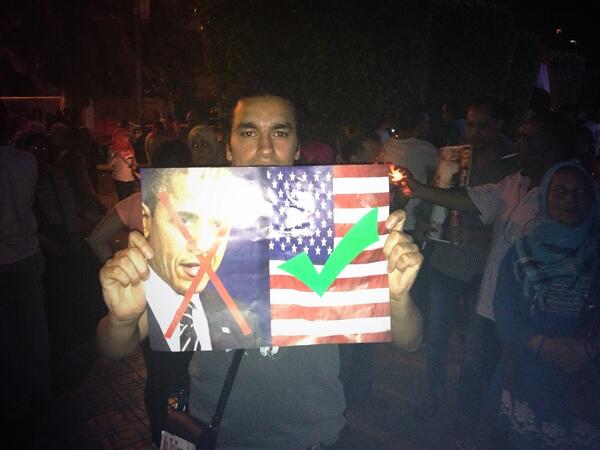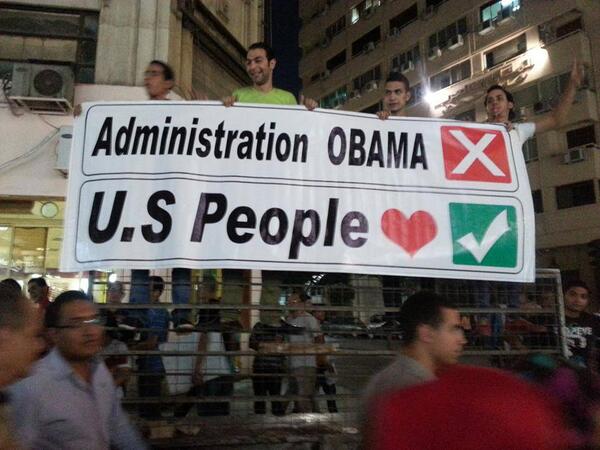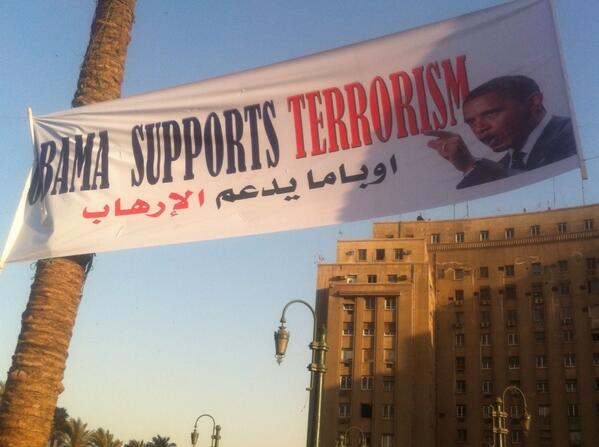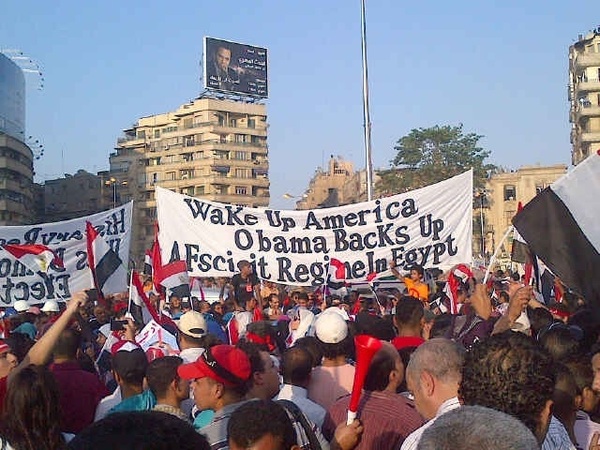




Posted on 07/09/2013 3:00:27 AM PDT by LD Jackson
The people in Egypt have made it clear they do not like President Obama. Obama's support for their ousted leader, Mohamed Morsi, did not sit well with the Egyptians and they wasted no time in displaying their displeasure during protests over the last few days.
Obama has claimed that the United States isn't aligned with or supporting any particular group or political party. His actions tell a different story. Obama gave Egyptian President Morsi $250 million in March in addition to 200 Abrams tanks and 12 F-16s, with 8 more to be delivered by the end of the year. Pretty strong support for the Muslim Brotherhood, of which Morsi is a member.
The White House released a statement which said, "The United States categorically rejects the false claims propagated by some in Egypt that we are working with specific political parties or movements to dictate how Egypt's transition should proceed. We remain committed to the Egyptian people and their aspiration for democracy, economic opportunity and dignity. But the future path of Egypt can only be determined by the Egyptian people."
Well the Egyptian people certainly are determining their own path, having ousted the Muslim Brotherhood's man, Mohamed Morsi. And in the process they have shown clear contempt for Obama and his ambassador in Egypt, Anne Patterson, for supporting Morsi.
While all the turmoil in Egypt continues, the civil war in Syria rages on and protests in Turkey abound, Secretary of State John Kerry is being dispatched to deal with the country Obama sees as the regional problem - Israel.
Could Obama's Middle East policy possibly be more preposterous?
Since the F-16’s can only be used to threated Israel, can we at least hold up delivery of the next 8?
The tanks are simply mobile pillboxes to keep crowds under control. But if they’re used that way and the Muslim Brotherhood gets the new Iranian, Russian or Chinese anti-tank weapons we shall find the Abram’s vulnerable parts. (Hint, it’s in the back, below the turret.)
It’s rare to see the ass end of an M1 Abrams when it’s looking to kill you.
Well, he did this brilliantly, alienating allies, encouraging foes and setting back US Foreign policy 40 years.
When all else fails, send an incompetent Sec. of State (Heinz ketchup) to the region in order to pressure Israel (for the 456th time) to release PLO Terrorists with blood on their hands.
Yes, it makes sense for a misguided and befuddled administration that is no longer leading from behind but just being a behind...
...where the Israeli Merkava tank has dangling iron balls on chains...





Same old, same old...US puts all it’s (advanced) eggs in one basket (case) state. That state implodes, America’s enemies get US secrets. How many times has this happened already. Give the stuff to Israel...they know how to use and KEEP it.
“It’s rare to see the ass end of an M1 Abrams when it’s looking to kill you.”
American tank losses in battle are very small. That’s because the US Army uses very good battlefield tactics. However, the Arabs use tanks as mobile pillboxes. They send tanks out without supporting troops and sit them on street corners. The back end is readily available. The Israelis lost an undisclosed number of Merkavas because in order to protect the rear you have to kill anybody you pass. But most of those are civilians. The guys with the new anti-tank missiles are dressed as civilians. Once the tank passes, they pick up the missile, which probably costs around $10,000 and kill a 44-55 million dollar tank. Israel has announced it is planning on removing all 1500 Merkavas because they are vulnerable to this cheap missile.
FOX news reported Obama is NOT cutting off US aid to Egypt (even though US law denies aid to govts deposed via muilitary coup).
NOTE .....the Egyptian military is neither under civilian control nor primarily financed by the Egyptian government. It gets its manna via more than $1 billion annually in US foreign aid......plus a host of additional US-financed programs......
THE MAGIC WORD$$$$: Egypt just says they'll be "a-good-neighbor" and billions of tax dollars start flowing.
===================================================
HERE'S WHAT THE LEFT IS SAYING:
EXCERPT---How much does the U.S. spend on Egypt? Egypt gets the most U.S. foreign aid of any country except for Israel. (This doesn't include the trillions of tax dollars spent on the Iraq and Afghanistan wars.)
The exact amount varies from year to year and there are many different funding streams, but U.S. foreign assistance to Egypt has averaged about $2 billion a year since 1979, when Egypt struck a peace treaty with Israel following the Camp David accords, according to the Congressional Research Service. That includes military and economic aid, though the latter has declined by more than two-thirds since 1998, according to a recent Congressional Research Service report.
Let's start with the military aid. How much is it, and what does it buy? Military aid — which comes through a funding stream known as Foreign Military Financing — has held steady at about $1.3 billion since 1987. American officials have long argued that the money promotes strong ties between the American and Egyptian militaries, which gives the U.S. all kinds of benefits. U.S. Navy warships, for instance, get "expedited processing" when they pass through the Suez Canal.
Here's a 2009 U.S. embassy cable released by WikiLeaks that makes essentially the same point: President Mubarak and military leaders view our military assistance program as the cornerstone of our mil-mil relationship and consider the USD 1.3 billion in annual FMF as "untouchable compensation" for making and maintaining peace with Israel. The tangible benefits to our mil-mil relationship are clear: Egypt remains at peace with Israel, and the U.S. military enjoys priority access to the Suez Canal and Egyptian airspace.
The military funding also enables Egypt to purchase US-manufactured military goods and services. But a 2006 report from the Government Accountability Office (PDF) criticized both the State Dept and the Defense Dept for failing to measure how the funding actually contributes to U.S. goals.
Does this aid require Egypt to meet any specific conditions regarding human rights? It didn't for a long time. When an exiled Egyptian dissident called on the U.S. to attach conditions to aid to Egypt in 2008, Francis J. Ricciardone Jr., who had recently stepped down as the U.S. ambassador to Egypt, told the Washington Post the idea was "admirable but not realistic." And Defense Secretary Robert Gates said that military aid "should be without conditions" at a Cairo press conference in 2009.
Last December Sen. Patrick Leahy, a Vermont Democrat, led Congress in adding language to a spending bill to make aid to Egypt conditional on the secretary of state certifying that Egypt is supporting human rights and being a good neighbor to Israel. The language requires that Egypt abide by the 1979 peace treaty with Israel, support "the transition to civilian government including holding free and fair elections," and put in place policies to protect freedom of expression, association, and religion, and due process of law." It sounds pretty tough, but it's not.
So has American aid to Egypt been cut off? No. Congress threatened to block the aid when Egypt began a crackdown on a number of American pro-democracy groups this winter. A senior Obama administration official said that Secretary of State Hillary Rodham Clinton had no way to certify the bill's conditions were being met.
But in March Clinton waived the certification requirement (yes, she can do that) and approved the aid, despite concerns remaining about Egypt's human rights record. The reason? "A delay or cut in $1.3 billion in military aid to Egypt risked breaking existing contracts with American arms manufacturers that could have shut down production lines in the middle of Obama's re-election campaign," the NYT reported. Breaking the contracts could have left the Pentagon on the hook for $2 billion.
What kind of arms have we been sending them, anyway? According to the State Department, the aid has included fighter jets, tanks, armored personnel carriers, attack helicopters, antiaircraft missiles, and surveillance aircraft. In the past, the Egyptian government has bought some of the weaponry on credit.
What about economic aid and efforts to promote democracy? U.S. economic aid to Egypt has slumped from $815 million in 1998 to about $250 million in 2011. The various economic aid efforts have had mixed results.
The State Department has described the Commodity Import Program, which gave Egypt millions of dollars between 1986 and 2008 to import American goods, as "one of the largest and most popular USAID programs."
<><> But an audit of the four-year, $57 million effort to create agricultural jobs and boost rural incomes in 2007 found that the program "has not increased the number of jobs as planned" [PDF].
<><> And an audit of a $151 million program [PDF] to modernize Egypt's real estate finance market in 2009 found that, while the market had improved since the program began, the growth was "not clearly measureable or attributable" to the aid efforts.
The U.S. has also funded programs to promote democracy and good government in Egypt — again with few results. It has sent about $24 million a year between 1999 and 2009 to a variety of NGOs in the country. According to a 2009 inspector general's audit [PDF], the efforts didn't add much due to "a lack of support" from the Egyptian government, which "suspended the activities of many U.S. NGOs because Egyptian officials thought these organizations were too aggressive."
President Obama has promised Egypt $1 billion in aid to support its transition to democracy following the fall of President Hosni Mubarak. But the funding has become a political issue since the attacks on the American embassy in Cairo on Sept. 11.
When the Obama administration announced that it was sending the Egyptian government $450 million to help forestall a budget crisis, Representative Kay Granger, a Texas Republican and the chairwoman of a subcommittee that oversees foreign aid, said she would block the money because of concerns about Egypt's direction under the Muslim Brotherhood. "I am not convinced of the urgent need for this assistance and I cannot /support it at this time," she said in a statement.
The Iranians distributed a very interesting video some time back. It’s not well known - it was in a consignment of instructions and weapons that they were trying to det into Gaza.
Basically it is a homemade throw-bomb, big as a molotov coctail, but with an EFP.
“Israel has announced it is planning on removing all 1500 Merkavas because they are vulnerable to this cheap missile.”
I went looking for the article on Israel’s plans to take the Merkava out of service, but could not find it. It was in a military magazine with a title something like “Defense Review.” The article spoke as if the decision had been made already. The artist rendering of the replacement looked like a VW bug with a gun. It appeared to be an RPV. The Israelis lost too many Merkavas when they went into Lebanon.
The real vulnerability of the Abrams is the line of tanker trucks that must follow it into action. Hamas and Hezbollah have Iranian built RPV’s that will likely buzz over the tanks and attack the tankers.
The horror remains that,
under the First Undocumented Moslem,
the US current ROE is to lie down without weapons,
ignore fellow soldiers being raped and murdered,
and wait to be beheaded or KIA
when the enemy is typical, garden variety,
Islamic terrorism (FOO).
One would think the US Pentagon, having been
HIT on 911 by Islamic terrorists, would WAKE UP.
CONGRESS WATCH The Washington Report on ME Affairs--Nov 2011.
Copyright 1983-2013 American Educational Trust
By Shirl McArthur, retired U.S. foreign service officer and Washington-based consultant.
The 2011 current estimate by the Washington Report on Middle East Affairs of cumulative total U.S. direct aid to Israel is $123.202 billion (updating November 2008 issue report). Because parts of U.S. aid to Israel are buried in the budgets of various U.S. agencies or in a form not easily quantified—such as the early disbursement of aid, giving Israel a direct benefit of interest income and the U.S. Treasury a corresponding loss—it is virtually impossible to arrive at an exact dollar amount.
Our latest estimate is a conservative, defensible accounting of U.S. direct aid to Israel. It does not include the indirect benefits to Israel resulting from U.S. aid, nor the substantial indirect or consequential cost to the U.S. as a result of its blind support for Israel.
Most significantly, perhaps, it does not include the costs resulting from the U.S. invasion and occupation of Iraq—hundreds of billions of dollars, thousands of U.S. and allied casualties, and untold tens of thousands of Iraqi killed and wounded—which is widely believed in the Arab world, and by many Americans as well, to have been undertaken for the benefit of Israel.
Among the real benefits to Israel that are not counted as a direct cost to the U.S. taxpayer is the provision allowing Israel to spend 26.3 percent of each year's military aid in Israel rather than from American companies (no other recipient of U.S. military aid gets this benefit), which has resulted in an increasingly sophisticated Israeli defense industry.
As a result, according to the Congressional Research Service (CRS), between 2001 and 2008 Israel was the seventh-largest arms exporter to the world, with total sales of $9.9 billion. Also in contrast with other countries receiving U.S. military aid, who must purchase through the Department of Defense (DOD), Israel deals directly with the U.S. companies, with no DOD review.
Loan Guarantees Another indirect benefit to Israel is the loan guarantees that Washington has extended to Israel since 1972. While these have not yet cost the U.S., they have enabled Israel to borrow from commercial sources at more favorable terms and lower interest rates, since the U.S. guarantees payment of the loans should Israel default.
Most recently, the FY '03 war supplemental appropriations act authorized $9 billion in loan guarantees to Israel over three years. In FY '05 these were extended until FY '07, and in '06 they were extended again through FY '11, with a "carryover" provision that Israel may draw on unused U.S. guarantees through FY '12. CRS reported that Israel has not borrowed any funds against these guarantees since FY '05, speculating that it perhaps views the guarantees as a "last resort" option should their normal source of funds—unguaranteed local and international bond issuances—become too expensive.
Subsidies for Israel's Colonists And Colonies A real benefit to Israel that represents another indirect, but unquantifiable, cost to the U.S. taxpayer is the private, tax-exempt money collected by charitable American Jewish groups and then sent to support Israel's colonists ("settlers") and colony-related causes in occupied Palestinian territories, including by groups designated by the U.S. as foreign terrorist organizations (see November 2007 Washington Report, p. 30).
In July 2010, The New York Times published a lengthy article on these "charities," reporting that hundreds of millions of dollars have flowed to settlers and settlement-related causes, including to support settler extremists in Hebron and East Jerusalem.
While most of the money appears to have gone to purposes that are legal under U.S. laws, the NY Times reported, it added that US funds have "also paid for more legally questionable commodities: housing as well as guard dogs, bulletproof vests, rifle scopes and vehicles to secure outposts deep in occupied areas."
Since every tax-exempt dollar that goes to the colonies represents a loss of, conservatively, 20 cents to the U.S. Treasury, that means that the U.S. taxpayer has indirectly subsidized Israel's illegal colonies to the tune of tens of millions of dollars, or more.
As with previous Washington Report estimates of U.S. aid to Israel, this report draws largely from CRS' latest report on "U.S. Foreign Aid to Israel," which uses available and verifiable numbers, primarily from the foreign operations appropriations bills. Table 1. at web site is based on the appendix to that report plus this magazine's reporting and research, especially for the columns showing DOD funds and interest income to Israel resulting from the early disbursement of aid.
Not counting the huge sums (in the trillions) being spent in Iraq and Afghanistan over the past decade, Israel is the largest cumulative recipient of U.S. aid since World War II. The $3 billion or so per year that Israel receives from the U.S. amounts to about $500 per Israeli.
The largest amounts have been military grants (Foreign Military Financing, or FMF) and economic grants (Economic Support Funds, or ESF). In August 2007 the U.S. and Israel agreed on a new, 10-year aid plan, beginning in FY '09 and calling for no ESF and incremental annual increases in FMF, reaching $3 billion by FY '11 and remaining at that level through FY '18.
Another ongoing item is so-called "migration and refugee assistance." This originally was intended to help Israel absorb Jewish refugees from the Soviet Union, but was expanded in 1985 to include "refugees resettling in Israel." In fact, however, Israel doesn't differentiate between refugees and other immigrants, so this money subsidizes all immigrants to Israel.
Israel also receives regular grants from the "American Schools and Hospitals Abroad" (ASHA) program.
A significant amount of aid to Israel comes from the DOD budget for so-called "joint defense projects" —although to date the Pentagon has shown little interest in these projects for its own use. Previous Washington Report estimates identified about $7.694 billion to Israel from the DOD budget through FY '08.
To that has been added amounts for FYs '09, '10 and '11, as shown in Table 1. at web site Of the $415 million shown for FY '11, the most significant amount is the $205 million appropriated to support Israel's "Iron Dome" short-range missile defense system.
A significant part of U.S. support for Israel's defense program is the deployment to Israel in 2008 of the X-Band radar system to detect incoming missiles. Since this system is U.S.-owned and -operated (meaning the constant presence on Israeli soil of U.S. troops and defense contractors), its costs are not reflected in these numbers.
Table 1. at web site also shows a conservative estimate of Israel's interest income resulting from the early disbursement of U.S. aid. Assuming that Israel's aid money is drawn down over the course of each year, a 2 percent interest rate is applied to one-half of the aid for FY '09 and '10, and a 3 percent rate for FY '11.
The "All Other" column on Table 1. at web site reflects information from the CRS report, plus this magazine's reporting and research, giving amounts from other U.S. departments and agencies.
Our 2006 report uncovered $456.7 million in previously unreported grants and endowments, mostly to U.S.-Israeli scientific organizations. The two largest are the BIRD Foundation (research and development) and the BARD Fund (agricultural research).
The BARD Fund gets about $500,000 a year from the Agriculture Department. In addition, in each of FY '09 and '10, Congress appropriated $2 million from the Energy Department for the U.S.-Israeli Energy Cooperation Program, and in FY '10 the Energy Department announced that it would contribute $3.3 million to the BIRD Foundation for clean energy projects.
For those who wish to look up more details, Table 2. at web cite gives citations for the foreign aid and DOD appropriations bills for the past five years.
The Arabs are nuts.
During Ramadan, they are even crazier.
Watch out a hungry and tired Islamicist might place himself next to you and then it's...SHAHID time.
The Marxist is a world wide failure and he actually thought he would be LOVED and admired.
What an arrogant ass.
But Obama just said that he didn’t support Morsi.
What could come out a preposterous administration but preposterous policy?
Seriously.
Disclaimer: Opinions posted on Free Republic are those of the individual posters and do not necessarily represent the opinion of Free Republic or its management. All materials posted herein are protected by copyright law and the exemption for fair use of copyrighted works.